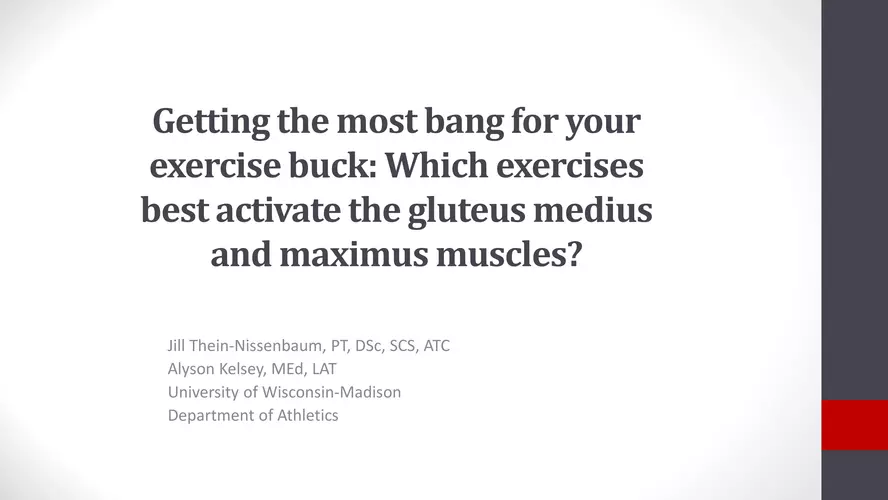
Which exercises best activate the gluteus medius and maximus
After observation, demonstrate appropriate performance of exercises for the gluteal muscles. Page 4. ? Proximal Attachment: Ilium (inverted ?U?).
adsPart of the document
Getting the most bang for your
exercise buck: Which exercises
best activate the gluteus medius
and maximus muscles?
Jill Thein-Nissenbaum, PT, DSc, SCS, ATC
Alyson Kelsey, MEd, LAT
University of Wisconsin-Madison
Department of Athletics
The speakers
No conflict of interest
Objectives for today:
Compare various gluteal strengthening exercises, and, based upon electromyographical
(EMG) findings, identify which exercises preferentially activate the gluteus medius and
maximus.
Choose appropriate gluteal rehabilitation exercises based upon the patient's functional level.
Identify which exercises demonstrate a higher percent maximal voluntary isometric
contraction (%MVIC) of the gluteus medius while concurrently demonstrating a lower %MVIC
of the tensor fascia latae (TFL).
After observation, demonstrate appropriate performance of exercises for the gluteal
muscles.
Gluteus Medius
Proximal Attachment: Ilium (inverted "U")
Distal Attachment:lateral aspect of the greater trochanter
of the femur
Innervation:Superior gluteal nerve (L4, L5, S1)
Action:Abduction of the hip, the anterior
fibers MAY do hip IR; the posterior fibers
definitely DO ER
Gluteus Medius
Accounts for 60% of abductor muscle group size
(the gluteus minimus is most of the rest)
Generates a great deal of force for its size
Weakness is commonly seen in closed chain, where weakness results in a
Trendelenburg gait, GM lurch, femoral IR, knee valgus, patella (relatively) lateral
deviation, and/or midline crossover with running
Clinical Pearl
Gluteus medius weakness from a L5 radiculopathy:
Gluteus medius nerve root is mostly L5
L5 is the most commonly involved nerve root with herniated nucleus pulposis / disc
Weakness of the gluteus medius
will cause trendelenberg gait, resulting
in lumbar sidebending to the affected
side, potentially causing more
narrowing of the vertebral foramen,
pinching the nerve root even more.....
MMT
TFL:Abd with Flexion (or IR)
*Gluteus Medius:
Abd with extension (or ER or IR????)
Gluteus Minimus: Pure Abd
* When performing the MMT of the gluteus medius, if the muscle is weak,
you might feel the patient pull the hip into flexion as you resist, using the TFL
Importance of the Gluteal Muscles in LE
Function
15 subjects with PFP; 26% less abduction and 36% less hip ER
strength
20 females with PFP; had 52% less hip extension strength, 27%
less hip abduction strength, and 30% less hip external rotation
strength
13 NCAA III athletes with PFP; 5 of 6 hip muscles tested were
weaker than sport-matched controls
Ireland, JOSPT, 2003
Robinson et al, JOSPT, 2007
Cichanowski, MSSE, 2007
Clearly
The need for a strong gluteus medius (with good neuromuscular control and
appropriate timing) is essential
In addition, other hip abductors (the TFL) may need to be quieted, as the TFL will
cause the femur to internally rotate, which leads to PFP, knee valgus, whole limb
pronation, etc.
Figure 6 . Mean peak electromyography (EMG) for 5 test conditions as MVIC%. Five test
conditions included double limb stance (DLSt), single limb stance (SLSt), single limb squat
(SLSq), single limb stance on unstable surface (SLSt-U), and single limb squat on unstable
surface (SLSq-U). Single limb exercises resulted in significantly greater GMEd activity
compared with double limb stance.Single limb squat exercise produced significantly
greater GMed EMG activity compared with single limb stance. No significant difference
was found in Gmed EMG between like exercises on unstable as compared with stable
surface.
Start with subject in a side plank position with shoulders, hips, knees, and ankles
in line, and then to rise to plank position. The subject is allowed upper extremity
support as seen. While balancing on elbows and feet, the subject raises the top
leg into abduction for one beat and then lowers leg for one beat.
Subject maintains plank position throughout all repetitions
Boren et al, Int J Sports Phys Ther, 2011


